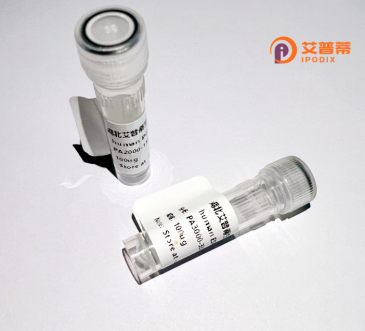
| 纯度 | >90%SDS-PAGE. |
| 种属 | Human |
| 靶点 | VGLL4 |
| Uniprot No | Q14135 |
| 内毒素 | < 0.01EU/μg |
| 表达宿主 | E.coli |
| 表达区间 | 1-290 aa |
| 活性数据 | METPLDVLSR AASLVHADDE KREAALRGEP RMQTLPVASA LSSHRTGPPP ISPSKRKFSM EPGDEDLDCD NDHVSKMSRI FNPHLNKTAN GDCRRDPRER SRSPIERAVA PTMSLHGSHL YTSLPSLGLE QPLALTKNSL DASRPAGLSP TLTPGERQQN RPSVITCASA GARNCNLSHC PIAHSGCAAP GPASYRRPPS AATTCDPVVE EHFRRSLGKN YKEPEPAPNS VSITGSVDDH FAKALGDTWL QIKAAKDGAS SSPESASRRG QPASPSAHMV SHSHSPSVVS |
| 分子量 | 30.9 kDa |
| 蛋白标签 | His tag N-Terminus |
| 缓冲液 | PBS, pH7.4, containing 0.01% SKL, 1mM DTT, 5% Trehalose and Proclin300. |
| 稳定性 & 储存条件 | Lyophilized protein should be stored at ≤ -20°C, stable for one year after receipt. Reconstituted protein solution can be stored at 2-8°C for 2-7 days. Aliquots of reconstituted samples are stable at ≤ -20°C for 3 months. |
| 复溶 | Always centrifuge tubes before opening.Do not mix by vortex or pipetting. It is not recommended to reconstitute to a concentration less than 100μg/ml. Dissolve the lyophilized protein in distilled water. Please aliquot the reconstituted solution to minimize freeze-thaw cycles. |
以下是关于人VGLL4蛋白的3篇代表性文献概览:
1. **文献名称**: *VGLL4 inhibits YAP-mediated transcription via competition for TEAD binding*
**作者**: Liu et al.
**摘要**: 揭示VGLL4通过竞争结合TEAD转录因子,抑制YAP驱动的基因表达,进而抑制肿瘤生长(Cell Research, 2016)。
2. **文献名称**: *VGLL4 acts as a tumor suppressor in gastric cancer by negatively regulating Hippo signaling*
**作者**: Zhang et al.
**摘要**: 发现VGLL4通过拮抗Hippo通路效应蛋白YAP,抑制胃癌细胞增殖并促进凋亡,提示其抑癌功能(Oncogene, 2017)。
3. **文献名称**: *Structural basis of VGLL4-YAP-TEAD complex formation in the Hippo pathway*
**作者**: Li et al.
**摘要**: 解析VGLL4与YAP/TEAD复合物的结构,阐明二者对TEAD结合域的竞争机制,为靶向药物设计提供依据(Nature Communications, 2020)。
部分文献可能存在多团队重复研究,建议根据具体需求通过PubMed/Google Scholar补充检索。
VGLL4 (Vestigial-Like Family Member 4) is a transcriptional cofactor belonging to the Vestigial-like protein family, which regulates cell proliferation, differentiation, and tissue development. It contains two conserved TDU domains (Tondu domains) that mediate interactions with TEAD transcription factors, key effectors of the Hippo signaling pathway. By competing with oncogenic coactivators like YAP/TAZ for TEAD binding, VGLL4 acts as a tumor suppressor, modulating gene expression involved in organ size control, apoptosis, and contact inhibition.
Studies highlight its dual roles: during embryogenesis, VGLL4 is essential for myogenesis, neuronal development, and cardiovascular formation, while in cancers (e.g., lung, gastric, liver), its downregulation correlates with poor prognosis. Structural analyses reveal that VGLL4’s TDU domains disrupt YAP-TEAD complexes, inspiring therapeutic strategies like peptide mimics to inhibit YAP-driven oncogenesis. Conversely, in specific contexts, VGLL4 may promote cancer metastasis via alternative pathways, underscoring its context-dependent functionality.
Recombinant human VGLL4 protein, produced via bacterial or mammalian systems, facilitates mechanistic studies and drug discovery. Its interplay with Hippo signaling continues to be a focus for understanding tissue homeostasis and developing precision oncology therapies.
×